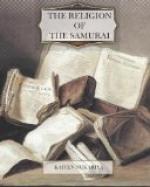The So To School 9,576
The Rin Zai School 4,523
The O Baku School 349
It was also in this period that Zen gained a great influence on the popular literature characterized by the shortest form of poetical composition. This was done through the genius of Ba-sho,[FN#105] a great literary man, recluse and traveller, who, as his writings show us, made no small progress in the study of Zen. Again, it was made use of by the teachers of popular[FN#106] ethics, who did a great deal in the education of the lower classes. In this way Zen and its peculiar taste gradually found its way into the arts of peace, such as literature, fine art, tea-ceremony, cookery, gardening, architecture, and at last it has permeated through every fibre of Japanese life.
[FN#105] He (died 1694) learned Zen under a contemporary Zen master (Buccho), and is said to have been enlightened before his reformation of the popular literature.
[FN#106] The teaching was called Shin-gaku, or the ’learning of mind.’ It was first taught by Bai-gan (Ishi-da), and is the reconciliation of Shintoism and Buddhism with Confucianism. Bai-gan and his successors practised Meditation, and were enlightened in their own way. Do-ni (Naka-zawa, died 1803) made use of Zen more than any other teacher.
13. Zen after the Restoration.
After the Restoration of the Mei-ji (1867) the popularity of Zen began to wane, and for some thirty years remained in inactivity; but since the Russo-Japanese War its revival has taken place. And now it is looked upon as an ideal faith, both for a nation full of hope and energy, and for a person who has to fight his own way in the strife of life. Bushido, or the code of chivalry, should be observed not only by the soldier in the battle-field, but by every citizen in the struggle for existence. If a person be a person and not a beast, then he must be a Samurai-brave, generous, upright, faithful, and manly, full of self-respect and self-confidence, at the same time full of the spirit of self-sacrifice. We can find an incarnation of Bushido in the late General Nogi, the hero of Port Arthur, who, after the sacrifice of his two sons for the country in the Russo-Japanese War, gave up his own and his wife’s life for the sake of the deceased Emperor. He died not in vain, as some might think, because his simplicity, uprightness, loyalty, bravery, self-control, and self-sacrifice, all combined in his last act, surely inspire the rising generation with the spirit of the Samurai to give birth to hundreds of Nogis. Now let us see in the following chapters what Zen so closely connected with Bushido teaches us.
CHAPTER III
THE UNIVERSE IS THE SCRIPTURE[FN#107] OF ZEN
1. Scripture is no More than Waste Paper.
[FN#107] Zen is not based on any particular sutra, either of Mahayana or of Hinayana. There are twofold Tripitakas (or the three collections of the Buddhist scriptures)-namely, the Mahayana-tripitaka and the Hinayana-tripitaka. The former are the basis of the Mahayana, or the higher and reformed Buddhism, full of profound metaphysical reasonings; while the latter form that of the Hinayana, or the lower and early Buddhism, which is simple and ethical teaching. These twofold Tripitakas are as follows:




